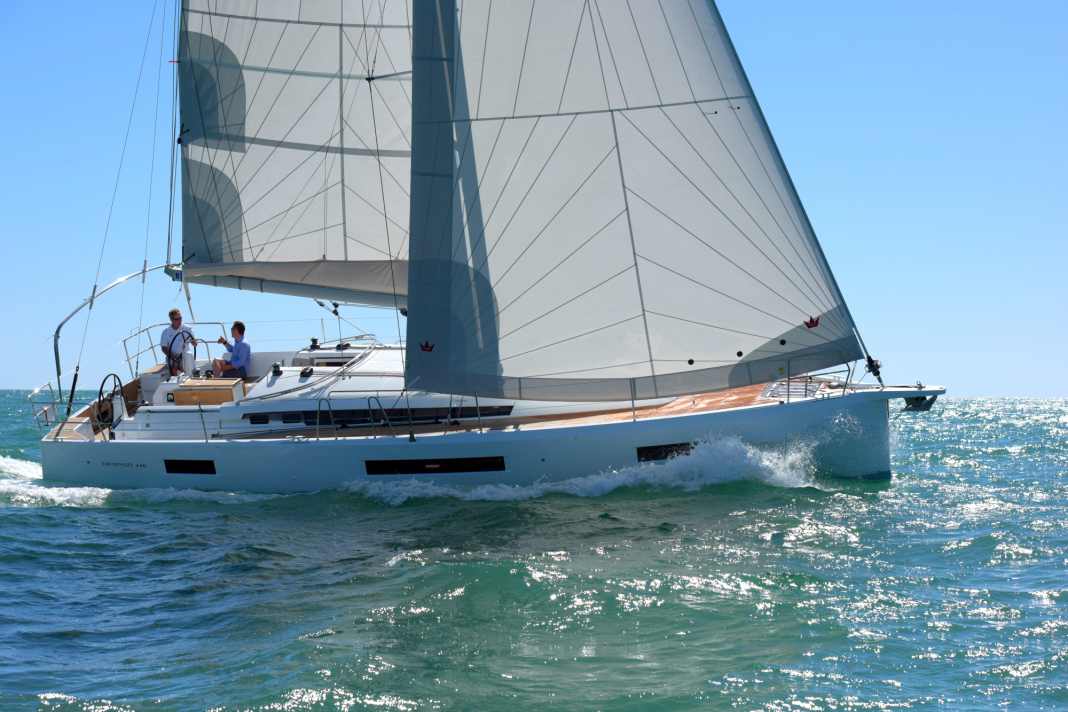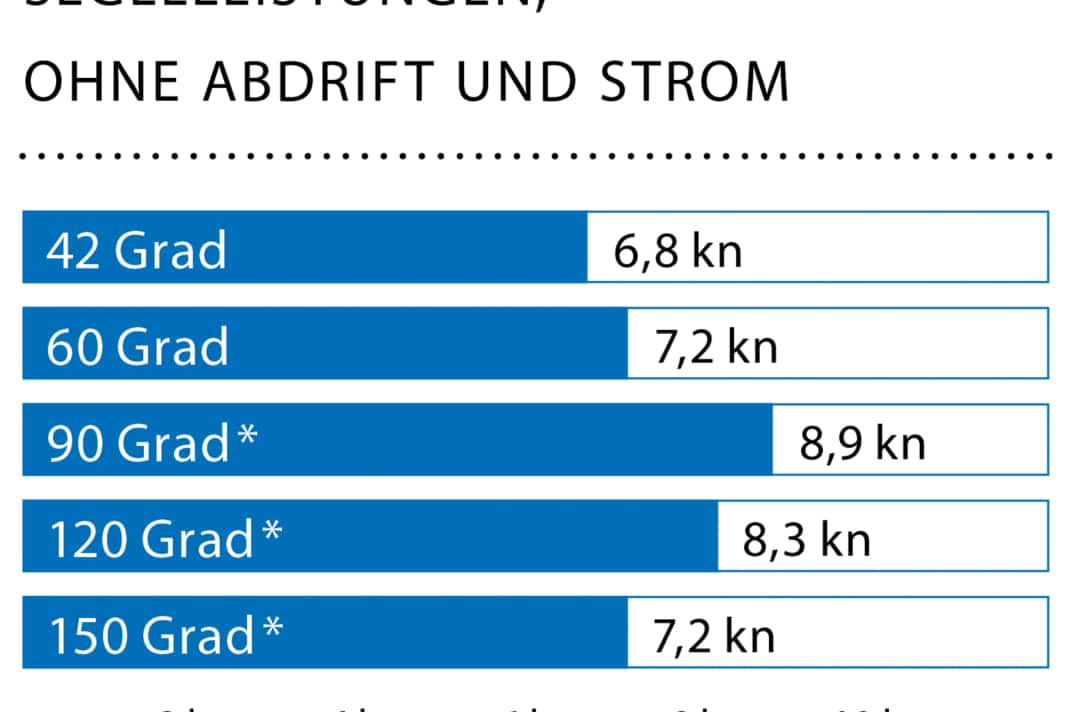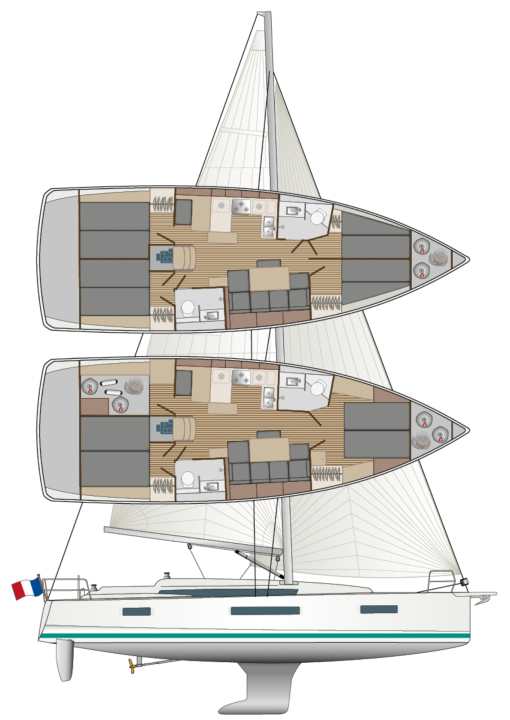Sun Odyssey 440: A cruising yacht full of ideas in the rarely served size segment
Michael Good
· 11.07.2024






For a long time, things had been rather quiet around Jeanneau's Sun Odyssey touring line. The yacht builders on the west coast of France had mainly updated their range by revising existing models and instead focussed on developing their motorboat programme. The Jeanneau range, the range of upmarket sailing yachts for the premium segment over 50 feet, was also expanded.
In 2017, however, the shipyard management returned to its roots and developed its core business again, i.e. the touring boats in the Sun Odyssey line and in the 10 to 15 metre hull length range. At the same time, Beneteau's in-house competitors announced a complete overhaul of their Oceanis cruising range, and Hanseyachts and Bavaria also launched new yachts in this size segment.
While Beneteau opted for a large ship with a hull length of around 15 metres for the start of the new programme (Oceanis 51.1YACHT 15/17), Jeanneau initially launched in the mid-size segment. The first boat was the Sun Odyssey 440, and as part of an exclusive agreement, the YACHT test editorial team had the opportunity to inspect and sail the prototype in advance. And it showed a concentrated load of innovation and fresh thinking. Mass-produced cruising boats are all the same? That's a thing of the past.
Tour without obstacles
In purely visual terms, the new ship is and remains a typical Jeanneau. Anyone expecting radical changes or a completely different appearance with the French company's programme renewal will be disabused. However, if you take a closer look at the ship, you will recognise some exciting and thrilling innovations. Probably the most spectacular detail is the side decks that slope aft, similar to ramps. They create veritable corridors that allow you to get from the aft cockpit around to the foredeck and back again without having to climb over the coaming.
The idea for this came from designer Philippe Briand himself, probably inspired by the so-called "walkaround" concepts for motorboats. This is a real novelty for sailing boats, at least for conventional aft cockpit yachts. The Moody brand, which belongs to the Greifswald-based Hansegroup, has already realised similar layouts around the cockpit with its DS yachts 45 and 54, albeit based on a genuine deck saloon concept and therefore not directly comparable with that of the new Sun Odyssey.
Also interesting:
In practice, this type of round trip around the cockpit works quite well, but also requires some familiarisation. Probably out of sheer routine, newcomers on board automatically take the more difficult but also shorter route directly over the cockpit coaming - especially under sail and when the passage at the helm station to windward is blocked by the helmsman anyway. In the harbour, on the other hand, people are happy to take the diversions around the back, especially with luggage. And older sailors in particular will be pleased with the stepless passages.
The lowered running deck also has hardly any disruptive effect on the space available in the aft cabins below deck, contrary to what one might expect. From this point of view, the unusual deck design is an unqualified gain in any case.
Appearance with character
The second exciting new feature in the cockpit of the Sun Odyssey 440 is the flexible coaming. Thanks to an ingenious mechanism, the backrests can be easily folded outwards in a single movement. This means that the comfortable seats can be effortlessly transformed into a large sunbed where two people can lie on either side (photo bottom right). This is also a good idea and a real novelty on the market.
However, there are other features that characterise the current generation of the Sun Odyssey. One is the extremely full bow section. The chine edges run from the stern almost to the bow stem. The additional volume at the front is intended to compensate for the enormous buoyancy of the very wide stern when sailing and ensure that the boat heels more evenly and dips less forwards over the bow.
Another feature that cannot be overlooked is the bevelled deck edge in the foredeck area - a feature that can often be seen in offshore racing. There, this is done to save weight at deck level and to minimise wind turbulence. In the case of the Jeanneau, these arguments are of course less important; it is much more about a modern and sporty appearance that should still look contemporary in the future. In this case, looks take precedence over function.
Because of its wide stern, the Sun Odyssey 440 is equipped with two rudder blades. Years ago, double rudder fins were generally considered to be rather lacking in temperament and not very conducive to steering feel, as well as having a lot of unwanted braking effect when manoeuvring. However, with the shift towards ever wider sterns, twin rudder blades have become more or less standard, even on designated cruising boats. Furthermore, design developments have already brought twin rudders very close to single rudders in terms of performance and response. Jeanneau and designer Philippe Briand also seem to want to definitely make this change with the current model generation.
Undoubtedly a good plan, as the Sun Odyssey 440 can confirm in ideal but also challenging test conditions off Les Sables d'Olonne on the west coast of France. With a westerly wind of around 15 knots and a fairly powerful swell of around 1.5 metres, the young Frenchwoman has to prove her skills. The Jeanneau effortlessly negotiates the high waves, entering the water cleanly and smoothly. And the pronounced chines are effective not only in terms of the balanced swimming position and great stability, but also as a welcome water deflector. Even against and in high swell, water is rare and the boat sails upright and pleasantly dry.
Difficult foundations
Steering is easy because it is very direct. And the 12.65 metre long and 8.5 tonne ship also reacts very quickly and immediately to the helmsman's course corrections. The Sun Odyssey 440 achieves 6.8 knots with the standard sails (main and genoa) close to the wind, with a tacking angle of 85 degrees. The good performance under sail is all the more astonishing as the test ship (the prototype) is equipped with a performance rig that is around one metre higher, but also with a short keel (1.60 metres instead of 2.20 metres). This setup is rather unusual and was deliberately designed by Jeanneau for testing reasons and for CE certification. With the standard deep keel matching the longer mast, the Sun Odyssey 440's performance should be even better.
As an alternative to the standard sail plan with the 120 per cent overlapping genoa, the new model can also be equipped with a self-tacking jib. Of course, additional space and downwind sails such as Code Zero or gennaker are also available. A bowsprit is now firmly laminated to the boat and can also be used as a step or anchor holder. A bow ladder could also be attached to it, for example for shallow jetties or for touring in the archipelago.
With this model series, Jeanneau also changed the supplier of the standard sails. These now come from Elvstrøm in Denmark and impress with good profiling and impeccable workmanship.
Easy to work with
Because the hinged coaming is not available for mounting sheet winches, Jeanneau has built additional winch platforms directly in front of the steering pillars. The main and genoa sheets are trimmed there alternately, within easy reach. Halyards, reefing and trim lines, on the other hand, are operated via the winches on the side of the companionway, as was previously the case. This separation ensures clear handling both when setting sail and during manoeuvres.
The boom is attached very low on the mast, which makes it easy to lay the sail nicely and close the lazybags during recovery, even without having to climb the mast. However, this makes the angle of action for the important boom vang very small, and operating it requires strength. Optional electric winches can make work on board much easier, even when trimming the mainsheet and genoa sheet.
The open bathing platform is 36 centimetres above the water surface - deep enough to be able to bathe your feet while seated and high enough to prevent the waves from constantly lapping against the hatch in the bay. There are also large storage compartments in the stern, which are accessible even when the bathing platform is closed. This is particularly important for accessing the life raft, which can be reached quickly and easily in an emergency.
The steering mechanism can also be easily accessed through the aft peak, allowing the double rudder blades to be easily adjusted. The simple system works via a single, continuous sheet cable without a central quadrant. Instead, the two rudder shafts are connected by a push rod. However, the system does not offer double safety in the event of a defect, as would be the case with two separate control cables. The Sun Odyssey can then only be steered using the autopilot or the emergency tiller.
Unrivalled classification
With a hull length of 12.65 metres for the new Sun Odyssey 440, Jeanneau sets itself apart from the competition. The competition from the major shipyard series (Bavaria, Beneteau, Dufour, Hanse) did not actually serve this length segment at all; it was not until 2024 that Dufour moved into this segment with the Dufour 44 after. The other shipyards are moving directly from the homogeneous twelve-metre class (41 feet) to the 46-foot boat with a hull length of 13.50 metres. Seen in this light, the 440 fills a gap between two important and popular length classes and therefore faces no direct competition.
This is also supported by the choice of two, three or four cabins below deck, but only two bathrooms. By way of classification: in the smaller 41-foot class, a maximum of three cabins and two washrooms are possible. In the larger 46-footers, up to four cabins are possible, each with its own bathroom.
The layout of the Sun Odyssey 440 below deck is also imaginative and different. As a speciality, Jeanneau has installed a large U-shaped galley in the middle of the saloon - a rare, if not unprecedented arrangement for boats of this size. However, the seating area on the starboard side is somewhat smaller. However, thanks to a sliding stool in the passageway to the foredeck, at least six people can still sit at the table with plenty of space.
The galley offers good functionality with large work surfaces and plenty of storage space. However, there is a lack of larger, closed compartments for storing crockery, pots and pans. By designing the galley as a large U, Jeanneau has gained space in favour of a proper navigation system that allows you to work properly with the chart while underway.
The electronics are also clearly arranged and easily accessible. However, Jeanneau should still work on the wiring behind the scenes. The cables are not laid neatly and are insufficiently labelled.
The quality of the interior fittings is essentially in line with the fairly well-made mass-produced standard
In the three-cabin version, the berths are exactly the same size both forward and in the aft compartments and are also rectangular: 2.00 metres long and 1.60 metres wide, i.e. luxurious dimensions. When converted into a two-cabin boat, the longitudinal bulkhead is moved aft by 40 centimetres to port. In this case, there would even be a sleeping area of 2.00 by 2.00 metres at the rear - a record-breakingly large bed. The quality of the berth cushions is pleasing, as they are now much thicker and therefore more comfortable than on the previous Jeanneau models. The upholstery in the saloon seating area is also very comfortable.
The quality of the interior fittings is essentially the same as that of the large series standard, which is also maintained by the competition. Only if you take a closer look below deck can you recognise minor flaws in the interior fittings, such as inconsistent gap dimensions or unfinished cut edges, for example on the storage compartment lids below the berths and the sofa in the saloon. Furthermore, the floorboards creak under load and are also difficult to open - unsightliness and shortcomings that can possibly be attributed to the prototype status. Jeanneau's product developer Erik Stromberg therefore already has quite a long list of improvements for series production for the new model. That's what a prototype is for.
As standard, the Sun Odyssey 440 is powered by a four-cylinder Yanmar diesel engine with 45 hp and shaft drive. However, this makes the 8.5-tonne vessel seem slightly underpowered for harbour manoeuvres. For greater safety, the more powerful 57 hp engine, which is available as an option, is recommended.
Jeanneau's designers are always looking for unusual and imaginative detailed solutions for their new developments - their motto seems to be to think outside the box instead of customising. The start of the new model generation once again provides a good example of this. The layout with the recessed running deck around the cockpit and the folding coamings are sure to provoke a lot of discussion in the industry. Jeanneau is once again leading the way in terms of innovation - an important point and advantage in the battle for customers.
The measured values for the test of the Sun Odyssey 440






The Sun Odyssey 440 in detail

Technical data of the Sun Odyssey 440
- Design engineer: Philippe Briand
- CE design category: A
- Torso length: 12,65 m
- Total length: 13,39 m
- Waterline length: 12,00 m
- Width: 4,29 m
- Draught/alternative: 2,20/1,60 m
- Theoretical torso speed: 8.4 kn
- Weight: 8,6 t
- Ballast/proportion: 2,3 t/27 %
- Mast height above waterline: 18,46 m
- Mainsail: 45,1 m2
- Furling genoa (120 %): 45,0 m2
- machine (Yanmar): 33 kW/45 hp
- Fuel tank (plastic): 200 l
- Fresh water tank (plastic): 330 l
- Holding tanks (plastic): 2 x 50 litres
Hull and deck construction
Hull: GRP full laminate with hand lay-up. Deck: GRP sandwich construction, built using the vacuum injection method
Price of the Sun Odyssey 440
- Base price ex shipyard: 336,650 euros gross incl. 19 % VAT
As of 07/24. How the prices shown are defined can be found here!
Shipyard
Chantier Jeanneau, 85505 Les Herbiers (France); www.jeanneau.com
Distribution
Dealer network
YACHT review of the Sun Odyssey 440
A promising start to a comprehensive new edition of Jeanneau's tour series. The concept features many innovations and a whole host of exciting details
Design and concept
- + New, innovative deck layout
- + New shapes, pleasing appearance
- + Sail load in the forecastle
Sailing performance and trim
- + Sails stiff and dry on the wind
- + Good reactions on the two oars
- - Sluggish mainsheet guide
Living and finishing quality
- + Large, square bunks
- + Spacious pantry in U-shape
- + Decent workmanship in detail
Equipment and technology
- + boom and sail easily accessible
- - Shoddy cabling
- - Standard machine weak
The article first appeared in YACHT 16/2017 and has been updated for the online version.

